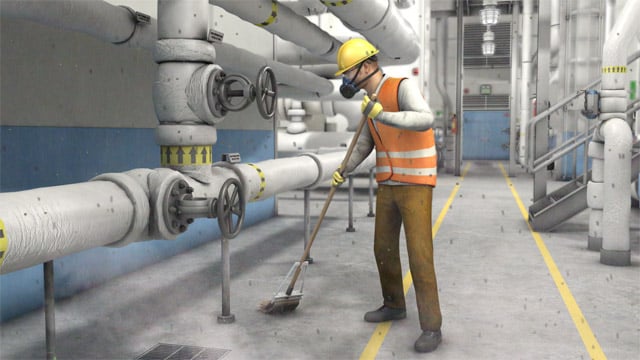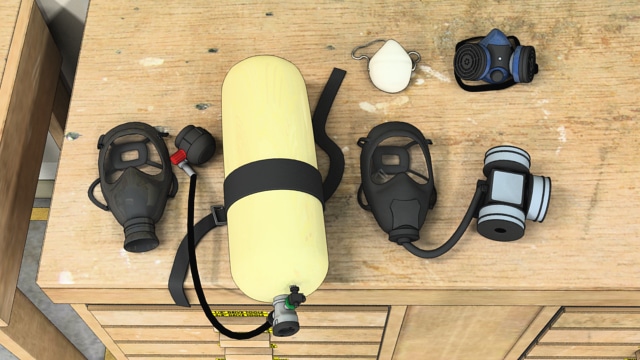



Respirator Basics
Respirators are essential for workplace safety, protecting users from hazardous environments. This course explains the fundamentals of respirators, including their types, the difference between air-supplying and air-purifying respirators, and the distinction between tight-fitting and loose-fitting respirators. It covers the use of respirators within the hierarchy of controls, assigned protection factor (APF), and best practices for cleaning, maintaining, inspecting, and storing respirators. Emphasis is also placed on the importance of respirator training and personal responsibility in effective respirator use.
Request a demoCourse Details
Learning Objectives
At the end of this course, you will be able to:
- Explain what a respirator is
- Identify three different types of hazardous environments that respirators can protect you from
- Explain the difference between air-purifying and air-supplying respirators
- Explain the difference between loose-fitting and tight-fitting respirators
- Explain the proper use of respirators within the hierarchy of controls
- Identify three factors to consider when selecting the proper respirator
- Explain assigned protection factor
- Explain the importance of and procedures for cleaning, inspecting, maintaining, and storing respirators
- Explain what you should learn during respirator training
- Explain the employee’s responsibility for safe respirator use
Specs
| Course Level | Fundamental |
| Languages | English, Arabic, Portuguese, Chinese, Dutch, French, German, Italian, Polish, Russian, Spanish, Czech |
| Compatibility | Audio, Video, MobileReady, Responsive |
| Based on: | 29 CFR 1910.134: Respiratory Protection |
Key Questions
A respirator is a piece of personal protective equipment that guards the wearer against hazards in the air.
What are some common types of respirators?Common types of respirators include air-supplying and air-filtering. They can also be categorized as loose-fitting or tight-fitting.
How does one select the proper respirator?All respirators are designed to provide protection in specific circumstances. The first thing to do is identify the circumstances (and the hazards) you will be working in. Then, select a respirator that provides protection in those circumstances and from those hazards.
What is the hierarchy of controls and what does it have to do with respirators?The hierarchy of controls is a method used to apply controls to hazards at a workplace. The idea is to start by trying to eliminate a hazard, then substitute something less hazardous, then use engineering controls, then work practice controls, and then personal protective equipment (PPE). So, respirators should be used only as a last line of defense against a hazard.
What is included in respirator training?Respirator training covers the types of respirators, their use, maintenance, and the importance of following safety regulations. Training ensures compliance with standards such as OSHA respirator training.
Sample Video Transcript
A respirator is a piece of personal protective equipment that guards the wearer against hazards in the air. There are many types of respirators. Each type protects its user from a specific airborne hazard. A respirator may protect against one hazard very well but give little or no protection against another type of hazard. For example, some respirators protect the user from particles flowing in the air. Others offer protection from airborne chemicals in environments with little or no oxygen, and still others offer protection in both environments. It’s important to understand the type of hazard a respirator was designed to offer protection from, and to know the limits of a respirator before using it on the job.
Additional Resources
- US Department of Labor Occupational Safety and Health Administration (OSHA) – www.osha.gov
- OSHA’s Respirator Protection Safety and Health Topic – https://www.osha.gov/SLTC/respiratoryprotection/index.html
- US Department of Labor Mine Safety and Health Administration (MSHA) – www.msha.gov
- MSHA Black Lung – www.msha.gov/endblacklung/
- MSHA Silicosis Prevention – www.msha.gov/S&HINFO/SILICO/SILICO.HTM
- The National Institute for Occupational Safety and Health (NIOSH) – www.cdc.gov/niosh/
- CDC/NIOSH Topics – www.cdc.gov/niosh/topics/respirators/default.html
Course Applies To
Demos + Pricing
Learn more about our courses, get pricing, and see our platform.











